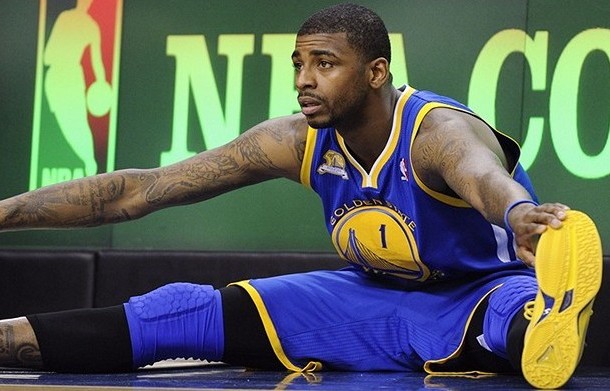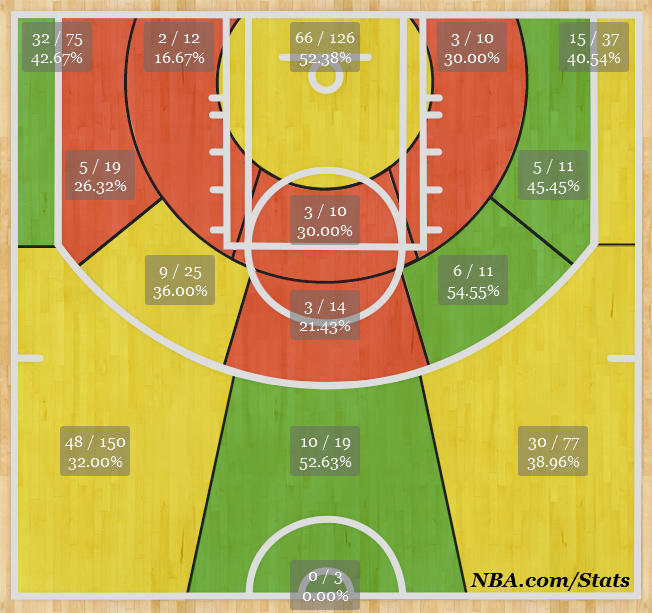The Basics
Age: 27
Height: 6’9″
Wingspan: 7’0″
Weight: 205 lbs
Some Basics
Smart offensive player who attempts most of his shots from high-efficiency areas
Below-average offensive rebounder, above-average defensive rebounder
Incredibly long, but not incredibly quick
His Offensive Game
At this point in Wright’s career, his offensive game is pretty clear. He has become a pretty good 3-point shooter (37.3% over his past four seasons) and knows this is where his true value lies, as he attempted 60% of his total field goal attempts last season from long range. Add another 21% of his attempts coming at the rim, and you’re left with only 19% of his attempts coming anywhere else, a sign of a player who knows where the high-efficiency scoring areas are on the court. This wasn’t a fluke, either; in the 2011-12 season, 79% of his field goal attempts came either at the rim or beyond the arc.
Dorell thrives as a catch-and-shoot player, as his height plus his vertical allow him to shoot over most defenders. He is not someone who you can expect to put the ball on the floor and beat his man to the rim, though, as his ball-handling skills are pretty poor. That being said, Wright knows his limitations, evidenced by his low turnover rate – among small forwards averaging over 22 minutes per game last season, only Shane Battier, Ersan Ilyasova, and Thaddeus Young turned the ball over less frequently (quite the opposite of what the Hornets were used to in seasons past from that position). His free throw rate is a little below average for his position, but considering how many of his field goal attempts are three-pointers, that statistic isn’t particularly worrisome (his FTR was right in line with guys such as Paul George and Rudy Gay in 2012-13).
Simply put, Dorell Wright is an intelligent player on offense – he is cognisant of what he can and can’t do, and knows which areas of the court to shoot from that most benefits his team.
His Defensive Game
Defensively, Wright reminds me a little bit of Aminu. Given his height and wingspan, one would assume that he would thrive on this end of the court as a defensive stopper. However, to this point, he has been no more than average. According to 82games.com, he has allowed an above average PER to opposing small forwards in two of the past three seasons. Last season, he finished just barely above the league average for small forwards in steals and blocks per 40 minutes, and is be a relatively disciplined defender as far as fouling is concerned. With the right tutelage, he should be able to better utilize his size on defense, but it cannot be forgotten that the same was assumed about Aminu.
Rebounding
Though Wright is a total non-factor on the offensive glass (largely because he spends most of his time behind the 3-point line), he is a pretty solid defensive rebounder. He posted a 17.0% defensive rebound rate last season; for comparison’s sake, the average defensive rebound rate for small forwards was 14.8% in 2012-13. He’s no Aminu in this part of the game, but he certainly wouldn’t hurt the Pelicans on the boards overall.
How He Fits
As McNamara stated in his opening column, the Pelicans should be looking for three things from their eventual small forward – perimeter shooting, rebounding, and defense. Wright is no less than average in each of these three areas; he is a well above average 3-point shooter who has the measurements to be a solid rebounder and defender as well. Monty Williams has shown the ability as a head coach to push role players beyond their expectations, and Dorell Wright could very well be the next player to fit that description.
Why You Should Want Him to Sign
As far as bang for your buck is concerned, the Pelicans may not get a better option than Wright. There could be as many as 10 small forwards who end up making more than him this offseason, but he could end up being better than close to half of them. With Jrue Holiday, Eric Gordon, Dorell Wright, and Ryan Anderson on the floor, it would give New Orleans four players with career three point percentages between 36.5% and 38.5%, meaning none of which could be left alone on the perimeter.
Expected Contract
3 years, $9 million
Wright’s last contract was for three years, making a total of $11.4 million. At age 24, that contract likely incorporated some hope for significant improvement as he entered his prime. While he is better now than he was three years ago, the difference isn’t nearly as significant as many may have hoped, and there is much less expectation for growth now than there was back then. As a result, 2 to 3 seasons at about $3 million per year seems like a reasonable to amount to expect Wright to command on the open market. Given what he can contribute to this Pelicans team, that could be a more than worthwhile investment.
(Photo credit: Howard Smith-US PRESSWIRE)


10 responses to “SF Prospect: Dorell Wright”
I think Wright has a better chance to be a starter with the Pels than Budinger, but I suspect these are being written with the best options later in the series.
Wright would be a solid NBA SF, and could be a guy who could start for say 1/3 of the NBA teams. That would be a bring improvement for the Pelicans/Hornets!
Wright is my guy at SF. I honestly like him for us more than Iggy when you consider price, fit, and age. Holiday had his breakout after Iggy was moved, Ty Lawson digressed last year after Iguodala was added. Iguodala is fantastic for your defense, but I would almost (key word) rather get a better fit for Jrue to run the pick n roll with that will cost us almost $10 million a year more. Wright provides excellent spacing and lets Jrue and Gordon have the ball in their hands more, and also provides better defensive rebounding than any of the other cheap SF options that can shoot the 3 consistently (I’m looking at you, Earl Clark.)
Well said guy with Ryno avatar, couldn’t agree more.
I’m interested to see if the Pels resume talks with GSW about swapping Klay for EJ. I’m assuming they would want us to take back Richard Jeffersons 11M (1 year) deal to make it work financially, but he could possibly provide us with a stop gap at the 3 spot and we’d have the flexibility to go after a center this offseason plus 11M off the books next year to fill in around the edges. Could kill a few birds with one stone, thoughts?
spatching3 would be way nice but I don’t think they will want to give up klay Thompson. Too talented for a young player.
Listen to interviews with him too. He seems like a classy guy with the kind of character that Monty and Dell like to have around.
How do his skills complement those of Ryan Anderson?
Dorell Wright is the man i want this off-seasom
This would be a nice pickup
Wouldn’t e disappointed, but wouldn’t celebrate either